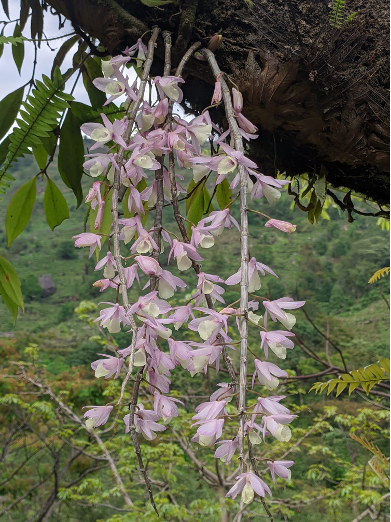Wildlife trade data raises concerns for orchids in Nepal
- Rhian Bland & Jacob Phelps
- Nov 19, 2021
- 3 min read
Updated: Apr 6, 2022
Orchids are traded around the world, harvested for their use in traditional medicines, foods, cosmetics, as well as for ornamental value. This includes a thriving commercial trade in Nepal that few conservationists are likely to have ever heard about
Nepal is home to more than 500 orchid species, almost a quarter of which are reportedly harvested for trade, mainly for their use in the traditional Ayurvedic and Chinese medicinal trade. Many of these species are likely sensitive to over-harvest and some, such as Dactylorhiza hatagirea, are of major conservation concern, although very few of Nepal’s orchid species have been evaluated for their conservation status by the IUCN Red List.
Little is known about the scale of this trade—or its legality. A new analysis of wildlife trade data reporting suggests there may be reason for concern.

A coalition of orchid conservationists to undertake a project to uncover the extent of illegal orchid trade in Nepal, supported by the UK Government through the Illegal wildlife Trade Challenge Fund. One of the team’s aims is to collect baseline data on the species most targeted for trade, including through an analysis of historical legal exports of orchids from the country, using the CITES trade database. This database records all legal trave permitted and reported by countries under the Convention on International Trade of Endangered Species of Flora and Fauna (CITES), which regulates the international trade of all orchids globally.
The project represents the first coordinated effort within the country to promote improved monitoring, reporting, enforcement and seizure of orchids to tackle illegal wildlife trade. Nepali conservation NGO Greenhood Nepal, supported by the IUCN SSC Orchid Specialist Group-Global Trade Programme and colleagues at 3 universities, have
undertaken the first review of trade data of orchids being exported from Nepal.
The review shows a sizeable commercial trade in wild orchids from Nepal: nearly 50,000kg were reported as legally exported between 2008-2016.
Importantly, discussions with government officials, harvester and traders make clear that the scale of unreported, illegal trade is certainly many times larger. Indeed, this is reflected in field visits by the team, which are documenting large volumes of wild orchids for commercial medicinal trade.
During this period, wild-harvested orchids accounted for 96% of orchid exports from Nepal, heavily dominated by the genus Dendrobium which, like other traded species such as Otichilus, are used for medicinal purposes. Indeed, many orchid species have pharmachemical compounds, although related research is still limited.

The hooded orchid, Dendrobium aphyllum. Orchids in the genus Dendrobium make up the majority of the legal orchid trade within Nepal.
Source: Basu Dev Neupane
The team has noted important discrepancies in the reporting of legal trade by Nepal and its importers; importing countries reported huge volumes of orchid imports from Nepal that Nepal never reported. For example, China reported importing 36,187kg orchids, whereas Nepal only reported 1,897kg. The official trade data also does not reflect any legal trade to India, yet there are a number of reports that orchids are traded in huge quantities to India, and there are herbal markets in India that publicly sell Nepalese orchids.
Such discrepancies point to serious failings in official wildlife trade reporting. This also suggest that many more wild plants are being illegally traded without being formally reported to CITES.
The team is also combing through reports of seizures of illegally-traded wildlife, and have identified at least 32 such events involving orchids between 2010-2020. This includes one case involving 75kg of the highly-protected Dactylorhiza hatagirea, representing almost 20,000 individuals of this endangered species.
The baseline data emphasises the need for proper monitoring of the legal orchid trade, and greater efforts to regulate the country’s trade—ensuring that legal trade complies with the law and is properly reported, and that illegal trade is enforced. The team are currently producing a policy brief for enforcement and conservation agencies in Nepal, highlighting the species at risk and encouraging better enforcement against large-scale commercial trade of wild plants.
You can keep up to date on the progress of the project as they explore how the trade can become sustainable and regulated via the#NepalOrchids hashtag on Twitter and via Greenhood Nepal’s social media (@GreenhoodNepal). The project is led by the Lancaster Environment Centre and Greenhood Nepal, alongside experts from the IUCN SSC Orchid Specialist Group, University of Hawaii, and University of Oxford.



Comments